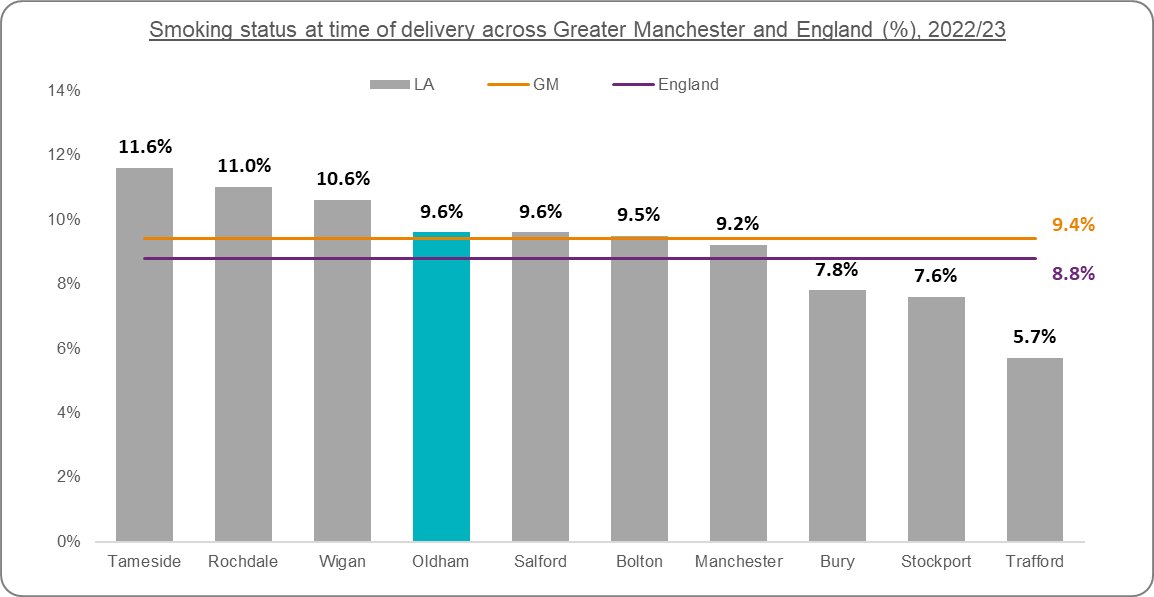Loading...
Smoking in pregnancy
Introduction
Smoking in pregnancy has well known detrimental effects for the growth and development of the baby and health of the mother. On average, smokers have more complications during pregnancy and labour, including bleeding during pregnancy, placental abruption and premature rupture of membranes.Encouraging pregnant women to stop smoking during pregnancy may also help them kick the habit for good, and thus provide health benefits for the mother and reduce exposure to secondhand smoke by the infant.
Smoking during pregnancy can cause serious pregnancy-related health problems. These include:
- complications during labour
- an increased risk of miscarriage
- premature birth (before 37 weeks of pregnancy)
- stillbirth
- low birth-weight
- sudden unexpected death in infancy (SIDS)
- birth defects
- increased risk of infant mortality
Data Overview
The number of women smoking at time of delivery has been on a steadily decreasing trend for both Oldham and England over the last decade. Oldham's rate has been consistently well above England averages for this time, although has seen a slightly better improvement in rate than nationally and so the gap is closing gradually.Oldham's latest data (2022/23) reveals that 9.6% of mothers are recorded as smoking at the time of delivery, this is higher than across Greater Manchester (9.4%) and England (8.8%) (Figure 1).
Figure 1: Smoking status at time of delivery trend
 Source: NHS Digital Return on Smoking Status at Time of Delivery (SATOD)
Source: NHS Digital Return on Smoking Status at Time of Delivery (SATOD)Table 1: Smoking status at time of delivery, Oldham, GM and England (%) | |||
| Year | Oldham | GM | England |
| 2010/11 | 17.5% | 17.0% | 13.6% |
| 2011/12 | 16.1% | 16.4% | 13.3% |
| 2012/13 | 16.8% | 15.6% | 12.8% |
| 2013/14 | 16.1% | 14.4% | 12.2% |
| 2014/15 | 13.5% | 13.8% | 11.7% |
| 2015/16 | 13.2% | 12.9% | 11.0% |
| 2016/17 | 13.3% | 12.5% | 10.7% |
| 2017/18 | 14.1% | 12.6% | 10.8% |
| 2018/19 | 13.6% | 11.7% | 10.6% |
| 2019/20 | 13.6% | 11.1% | 10.4% |
| 2020/21 | 11.0% | 9.8% | 9.6% |
| 2021/22 | 10.7% | 9.5% | 9.1% |
| 2022/23 | 9.6% | 9.4% | 8.8% |
Source: NHS Digital return on smoking status at time of delivery (SATOD) | |||
Oldham has the 4th highest rate of smoking at time of delivery across Greater Manchester (figure 2). Tameside is highest at 11.6% and Trafford lowest at 5.7%. Rates vary considerably across England, from 3.1% in Ealing to 19.4% in Blackpool. Oldham ranks 63rd highest of all Local Authorities (out of 152).
Figure 2: Smoking status at time of delivery across Greater Manchester
 Source: NHS Digital Return on Smoking Status at Time of Delivery (SATOD)
Source: NHS Digital Return on Smoking Status at Time of Delivery (SATOD)Modifiable risk factors in pregnancy can have health impacts on both mother and child. At booking appointment midwives will ask questions and perform tests to ascertain these risks and advise on recommended actions. Smoking status is collected as part of this risk assessment.
In 2018/19, 14.8% of mothers were recorded as smoking during early pregnancy in Oldham. Oldham's rate is higher than the Greater Manchester (13.2%) and the England averages (12.8%). Oldham ranks 4th highest across Greater Manchester and 54th highest (out of 152 Local Authorities) nationally.
Figure 3: Smoking in early pregnancy across Greater Manchester
 Source: Maternity Services Dataset (MSDS) v1.5
Source: Maternity Services Dataset (MSDS) v1.5Further Information & Resources
NHS Stop SmokingInformation and advice from the NHS surrounding the risks of smoking in pregnancy and services to help mothers quit.
OHID Child and Maternal Health Data Profile
For additional data and information relating to smoking during pregnancy.
NHS Digital Maternity Services Dataset
The Maternity Services Data Set (MSDS) is a patient-level data set that captures information about activity carried out by Maternity Services relating to a mother and baby(s), from the point of the first booking appointment until mother and baby(s) are discharged from maternity services.
...

